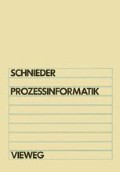Zusammenfassung
Für die Prozeßinformatik ist die Darstellung, Klassifizierung und Behandlung ihres Betrachtungsgegenstands nach funktionalen Eigenschaften charakteristisch. Das hat auch den Vorteil, daß solche Eigenschaften seltener Änderungen unterworfen sind; eine Darstellung nach rein technischen Merkmalen wäre beim gegenwärtigen Entwicklungstempo ständig zu aktualisieren.
Access this chapter
Tax calculation will be finalised at checkout
Purchases are for personal use only
Preview
Unable to display preview. Download preview PDF.
Literaturverzeichnis zu Kapitel 2
Ropohl, G. : Eine Systemtheorie der Technik. Carl Hanser Verlag, München, Wien 1979.
Locke, M. : Allgemeine dynamische Systeme - Probleme, Entwicklungsstand, Anwendungen. Nachrichtentechnik Elektronik 31 (1981) 11, 461–465.
Schmidt, G. : Was sind und wie entstehen komplexe Systeme, und welche spezifischen Aufgaben stellen sie für die Regelungstechnik. Regelungstechnik 30 (1982) 10, 331–339.
Plotkin, A. A. : Hierarchical systems of subsets. Automation and Remote Control 42 (1981) 5, Part 2, 670–675.
DIN 66 201 Prozeßrechensysteme.
Schnorr, R. : Optimale Strukturen von Informationsverarbeitungssystemen. Elektrotechnik und Maschinenbau 100 (1983) 6, 243–251.
Schmidt, B. : Informatik und allgemeine Modelltheorie — eine Einführung. Angewandte Informatik (1982) 1, 35–42.
Schweitzer, G. : The impact of modelling on the operation of transportation systems. In Klamt, D., Lauber, R. (ed.) : Proceedings of the 4th conference on control in transportation systems, Baden-Baden 1983, Pergamon Press, Oxford 1984, 17–29.
Pakhomov, V. F. : Information approach to the aggregation problem. Engng. Cybernetics 16 (1978) 4, 22–31.
Litz, L. : Dezentrale Regelsysteme. R. Oldenbourg Verlag, München, Wien 1983.
Page, B. : Der Gültigkeitsnachweis von komplexen Simulationsmodellen. Angewandte Informatik (1983) 4, 149–157.
Oberquelle, H. : Communication by graphic net representations. Bericht Nr. 75 des Fachbereichs Informatik, Universität Hamburg, März 1981.
Schumacher, F. : Beschreibung und Auswertung diskreter dynamischer Systeme. Kernforschungszentrum Karlsruhe, KFK Bericht Nr. 2635 Mai 1978.
Rights and permissions
Copyright information
© 1986 Friedr. Vieweg & Sohn Verlagsgesellschaft mbH, Braunschweig
About this chapter
Cite this chapter
Schnieder, E. (1986). Netzdarstellungen und grundlegende Begriffe. In: Prozeßinformatik. Vieweg+Teubner Verlag. https://doi.org/10.1007/978-3-322-86171-9_2
Download citation
DOI: https://doi.org/10.1007/978-3-322-86171-9_2
Publisher Name: Vieweg+Teubner Verlag
Print ISBN: 978-3-528-03358-3
Online ISBN: 978-3-322-86171-9
eBook Packages: Springer Book Archive

